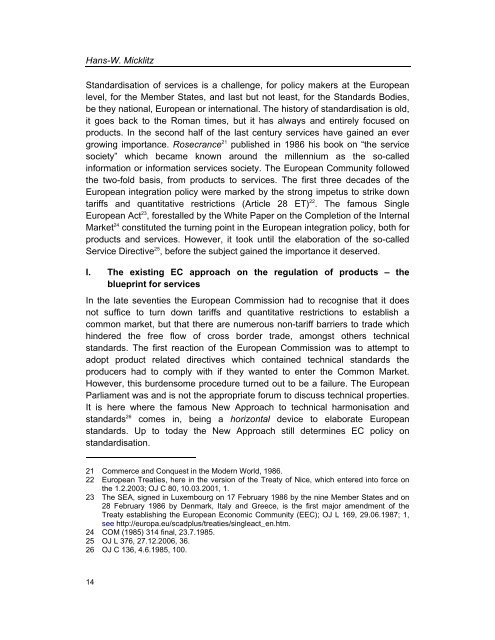Services Standards: Defining the Core Consumer Elements ... - ANEC
Services Standards: Defining the Core Consumer Elements ... - ANEC
Services Standards: Defining the Core Consumer Elements ... - ANEC
You also want an ePaper? Increase the reach of your titles
YUMPU automatically turns print PDFs into web optimized ePapers that Google loves.
Hans-W. Micklitz<br />
Standardisation of services is a challenge, for policy makers at <strong>the</strong> European<br />
level, for <strong>the</strong> Member States, and last but not least, for <strong>the</strong> <strong>Standards</strong> Bodies,<br />
be <strong>the</strong>y national, European or international. The history of standardisation is old,<br />
it goes back to <strong>the</strong> Roman times, but it has always and entirely focused on<br />
products. In <strong>the</strong> second half of <strong>the</strong> last century services have gained an ever<br />
growing importance. Rosecrance 21 published in 1986 his book on “<strong>the</strong> service<br />
society” which became known around <strong>the</strong> millennium as <strong>the</strong> so-called<br />
information or information services society. The European Community followed<br />
<strong>the</strong> two-fold basis, from products to services. The first three decades of <strong>the</strong><br />
European integration policy were marked by <strong>the</strong> strong impetus to strike down<br />
tariffs and quantitative restrictions (Article 28 ET) 22 . The famous Single<br />
European Act 23 , forestalled by <strong>the</strong> White Paper on <strong>the</strong> Completion of <strong>the</strong> Internal<br />
Market 24 constituted <strong>the</strong> turning point in <strong>the</strong> European integration policy, both for<br />
products and services. However, it took until <strong>the</strong> elaboration of <strong>the</strong> so-called<br />
Service Directive 25 , before <strong>the</strong> subject gained <strong>the</strong> importance it deserved.<br />
I. The existing EC approach on <strong>the</strong> regulation of products – <strong>the</strong><br />
blueprint for services<br />
In <strong>the</strong> late seventies <strong>the</strong> European Commission had to recognise that it does<br />
not suffice to turn down tariffs and quantitative restrictions to establish a<br />
common market, but that <strong>the</strong>re are numerous non-tariff barriers to trade which<br />
hindered <strong>the</strong> free flow of cross border trade, amongst o<strong>the</strong>rs technical<br />
standards. The first reaction of <strong>the</strong> European Commission was to attempt to<br />
adopt product related directives which contained technical standards <strong>the</strong><br />
producers had to comply with if <strong>the</strong>y wanted to enter <strong>the</strong> Common Market.<br />
However, this burdensome procedure turned out to be a failure. The European<br />
Parliament was and is not <strong>the</strong> appropriate forum to discuss technical properties.<br />
It is here where <strong>the</strong> famous New Approach to technical harmonisation and<br />
standards 26 comes in, being a horizontal device to elaborate European<br />
standards. Up to today <strong>the</strong> New Approach still determines EC policy on<br />
standardisation.<br />
21 Commerce and Conquest in <strong>the</strong> Modern World, 1986.<br />
22 European Treaties, here in <strong>the</strong> version of <strong>the</strong> Treaty of Nice, which entered into force on<br />
<strong>the</strong> 1.2.2003; OJ C 80, 10.03.2001, 1.<br />
23 The SEA, signed in Luxembourg on 17 February 1986 by <strong>the</strong> nine Member States and on<br />
28 February 1986 by Denmark, Italy and Greece, is <strong>the</strong> first major amendment of <strong>the</strong><br />
Treaty establishing <strong>the</strong> European Economic Community (EEC); OJ L 169, 29.06.1987; 1,<br />
see http://europa.eu/scadplus/treaties/singleact_en.htm.<br />
24 COM (1985) 314 final, 23.7.1985.<br />
25 OJ L 376, 27.12.2006, 36.<br />
26 OJ C 136, 4.6.1985, 100.<br />
14
















